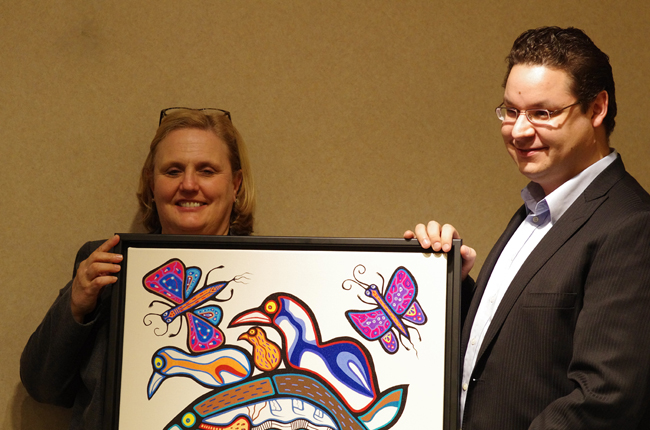Paintings part of healing process

By Rick Garrick
THUNDER BAY –Pic River’s Joe Moses thinks paintings are part of the healing process for First Nations patients.
“It’s a first step towards creating a welcoming environment for the Aboriginal patients that are coming from out of town,” says Moses, a board member of the Thunder Bay Regional Health Sciences Foundation, in presenting a framed Roy Thomas print to the local hospital. “We hope it just (adds) a little bit of a feeling towards home, wherever that may be.”
Thomas was an acclaimed Woodlands School artist from Long Lake #58 First Nation who died at the age of 55 in 2004. His work is featured in Thunder Bay’s Ahnisnabae Art Gallery, operated by his wife Louise.
The Thomas print was the first of a number of paintings that the foundation plans to donate to the TBRHSC.
“Any bit of home, whether it’s a painting or a friendly face or being able to speak your own language, like Kanita Johnson (Aboriginal liaison, renal services) provides, is a big step towards being comfortable,” Moses says.
Johnson is one of 25 members of the Aboriginal Advisory Committee who were introduced to the public at an April 22 event. The committee includes representatives from Aboriginal organizations across northwestern Ontario, patient and family advisors and hospital leaders who act in an advisory capacity to implement the Aboriginal strategic direction of the health centre’s current strategic plan.
“When our current strategic plan was being developed, we recognized that Aboriginal health needed to be a priority, and so it was identified as (one) of our four strategic directions,” says Andrée Robichaud, TBRHSC president and CEO. “The committee helps us to engage with the Aboriginal community on initiatives such as developing culturally-appropriate health plans, and creating a more welcoming environment for Aboriginal patients and their families.”
Fort William’s Sandra Cornell, another member of the Aboriginal Advisory Committee, looks forward to achieving better health services for First Nations community members.
“It’s slowly coming along — people are becoming more aware — but it’s still got a long way to go,” Cornell says. “We are getting more and more Aboriginal health care providers in the system and a lot of them are able to speak the language.”
Cornell says the recent hiring of a First Nations physician — Eagle Lake’s Shannon Wesley — is a change for the better.
“She has a lot of experience working in the north,” Cornell says. “It’s people that will make the difference. We are getting more Aboriginal health care providers in the system, which will make that difference.”
Cornell says many elderly patients from across the region, including Robinson Superior communities, need assistance with translation if they do not have good English language skills.
“They’re hemming and hawing and nodding their heads, but are they really understanding what their diagnosis is?” Cornell asks. “Are they really understanding their medication, what’s given to them? No, they’re not.”
In addition to Johnson and Wesley, TBRHSC has hired an Aboriginal engagement lead and patient advocate and two other staff dedicated to linking Aboriginal patients and families with healthcare providers, facilitating access to care, services, resources and culturally-appropriate support.


